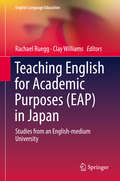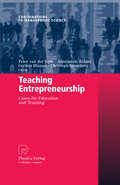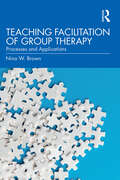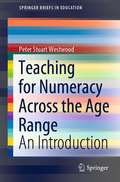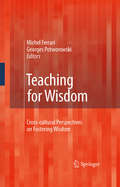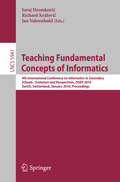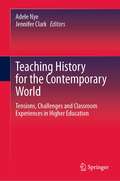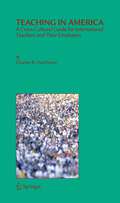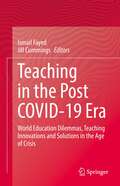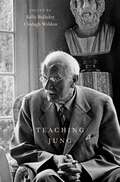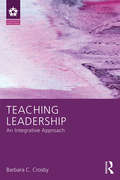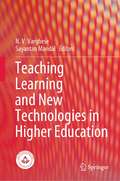- Table View
- List View
Teaching English for Academic Purposes: Studies from an English-medium University (English Language Education #14)
by Rachael Ruegg Clay WilliamsThis book focuses on appropriate English for Academic Purposes instructional concepts and methods in the Japanese context. It investigates a variety of pedagogical techniques, addressing the fundamental academic English skills – listening, speaking, reading and writing – as well as assessment and materials development. All the research included was conducted in Japanese university settings, thus shedding new light on the effective implementation of EAP teaching and learning activities with Japanese learners of English. This book is of interest to anyone working in an EAP context at the secondary or tertiary level, especially those which include Japanese learners.
Teaching Entrepreneurship: Cases for Education and Training (Contributions to Management Science)
by Peter Van Der Sijde Annemarie Ridder Gerben Blaauw Christoph Diensberg“Entrepreneurship that is something you learn in practice”. “Entreprene- ship is learning by doing”. This is often heard when you tell others that you teach entrepreneurship, but maybe entrepreneurship is more “doing by learning”. Nevertheless, in entrepreneurship practice and theory are int- woven. For this reason the Learning Cycle introduced by Kolb (1984) is an often used teaching approach. According to this Learning Cycle there are four phases (“cycle”) that are connected: 1. Concrete experience (“doing”, “experiencing”) 2. Reflection (“reflecting on the experience”) 3. Conceptualization (“learning from the experience”) 4. Experimentation (“bring what you learned into practice”) In teaching you can enter this cycle at any stage, depending on the students. And that brings us to the different types of students. Based on Hills et al. (1998) a plethora of student groups can be distinguished (of course this list is not exhaustive), e.g: Ph.D. students, who do a doctoral programme in Entrepreneurship; the emphasis is on theory/science. DBA students, who do a doctoral programme that is, in comparison to the Ph.D. more practice oriented. MBA students, who take entrepreneurship as one of the courses in their programme. Most of the time MBA students are mature students, who after some work experience return to the university; the programme is practice oriented.
Teaching Facilitation of Group Therapy: Processes and Applications
by Nina W. BrownTeaching Facilitation of Group Therapy explores an extensive range of topics crucial to effective teaching and practice, and will be a valuable resource for instructors of group therapy. With an emphasis on evidence-based methodologies, this book describes proven teaching techniques that foster a dynamic learning environment, facilitate group cohesion, and promote meaningful interventions. The author presents ethical considerations including those that relate to using social media in therapeutic practices, equipping readers with the knowledge to leverage its potential while safeguarding client confidentiality and well-being. This resource presents topics including therapeutic factors and effective interventions, the use of the group leader’s inner development as a guide for therapeutic alliance and group members’ healing, cutting-edge therapeutic AI applications, the role of self-absorption for members and the leader, group dynamics, ethical uses of social media in therapeutic settings, and serves as a comprehensive guide for instructors in the art of teaching group psychotherapy in the modern era. This is an indispensable resource for educators to elevate their expertise in teaching group psychotherapy and prepare clinicians and students by deepening their understanding of group dynamics, and how to employ effective interventions that promote healing and growth in therapeutic settings.
Teaching Facilitation of Group Therapy: Processes and Applications
by Nina W. BrownTeaching Facilitation of Group Therapy explores an extensive range of topics crucial to effective teaching and practice, and will be a valuable resource for instructors of group therapy. With an emphasis on evidence-based methodologies, this book describes proven teaching techniques that foster a dynamic learning environment, facilitate group cohesion, and promote meaningful interventions. The author presents ethical considerations including those that relate to using social media in therapeutic practices, equipping readers with the knowledge to leverage its potential while safeguarding client confidentiality and well-being. This resource presents topics including therapeutic factors and effective interventions, the use of the group leader’s inner development as a guide for therapeutic alliance and group members’ healing, cutting-edge therapeutic AI applications, the role of self-absorption for members and the leader, group dynamics, ethical uses of social media in therapeutic settings, and serves as a comprehensive guide for instructors in the art of teaching group psychotherapy in the modern era. This is an indispensable resource for educators to elevate their expertise in teaching group psychotherapy and prepare clinicians and students by deepening their understanding of group dynamics, and how to employ effective interventions that promote healing and growth in therapeutic settings.
Teaching Family Therapy (The Systemic Thinking and Practice Series)
by Ros Draper Myrna Gower Clare HuffingtonThe teaching of family therapy has been the subject of serious scrutiny since the onset of training and accreditation many years ago, yet there are relatively few attempts to apply what we know about systems and the ways they change family therapy teaching as a two-way process. It is as though family therapy teachers were preoccupied with the content of what should be taught, and were not able to direct their attention to the process by which people learned. The authors began by describing the way they conceptualize the "learning context" which sets the frame for all the teaching they do. Then they discuss the process of setting up a family therapy course, e.g. "What is the best way to negotiate with a training officer to set up a course in a local area?". The book then moves to creating the course syllabus, and some of the practical problems-from lateness to mechanical failures-of getting the course off the ground.
Teaching Family Therapy (The Systemic Thinking and Practice Series)
by Ros Draper Myrna Gower Clare Huffington Rosemary WhiffenThe teaching of family therapy has been the subject of serious scrutiny since the onset of training and accreditation many years ago, yet there are relatively few attempts to apply what we know about systems and the ways they change family therapy teaching as a two-way process. It is as though family therapy teachers were preoccupied with the content of what should be taught, and were not able to direct their attention to the process by which people learned. The authors began by describing the way they conceptualize the "learning context" which sets the frame for all the teaching they do. Then they discuss the process of setting up a family therapy course, e.g. "What is the best way to negotiate with a training officer to set up a course in a local area?". The book then moves to creating the course syllabus, and some of the practical problems-from lateness to mechanical failures-of getting the course off the ground.
Teaching for Creativity: Super-charged learning through 'The Invisible Curriculum'
by Andrew HammondThe Invisible Curriculum Series gives teachers the secret ingredients to unlock the full potential of children's learning abilities. Too often in formal schooling, creativity and curiosity are taught out of children. Teaching for Creativity offers practical advice on how to ensure that this does not happen. This book will help teachers to preserve children's innate creative capacities at the same time as maintaining academic standards in the classroom.
Teaching for Effective Learning in Higher Education
by N. HativaThis book identifies strategies that are consistently associated with good teaching and presents them within a theoretical framework that explains how they promote students' active and meaningful learning. The book promotes teachers' pedagogical knowledge and their perception of teaching as scholarly, intellectual work, and provides extensive practical advice.
Teaching for Motivation: Super-charged learning through 'The Invisible Curriculum'
by Andrew HammondThe Invisible Curriculum series gives teachers the secret ingredients that can fully unlock a child's learning potential. In Teaching for Motivation, Andrew Hammond proves that identifying a child's motivational needs and wants is key to powerful learning.
Teaching for Numeracy Across the Age Range: An Introduction (SpringerBriefs in Education)
by Peter Stuart WestwoodThis book provides an introduction to what it means to be numerate, and how numeracy can best be developed and nurtured in children and in adults. It also presents a cohesive coverage of numeracy development from early childhood to adulthood. This book draws on international research and practice to provide a comprehensive overview on the topic. It depicts and draws connections with the National Curriculum in the United Kingdom, the Australian Curriculum, and the Common Core State Standards in the United States. This book identifies skills and concepts involved in achieving functional numeracy, and provides practical advice on effective teaching, learning and assessment. It serves as a valuable guide to educators who teach mathematics in primary and secondary schools, but who are not specifically trained in the subject.
Teaching for Wisdom: Cross-cultural Perspectives on Fostering Wisdom
by Michel Ferrari Georges PotworowskiThis book examines if it is possible to teach wisdom. It considers how people at different times and places have engaged the age-old question of how (or whether) we can learn to live a good life, and what that life is like. Offering a range of perspectives, coverage considers Greek and Confucian philosophy; Christian, Islamic and Buddhist religion; African tradition, as well as contemporary scientific approaches to the study of wisdom.
Teaching Fractions through Situations: A Fundamental Experiment (Mathematics Education Library)
by Guy Brousseau Nadine Brousseau Virginia WarfieldThis work presents one of the original and fundamental experiments of Didactique, a research program whose underlying tenet is that Mathematics Education research should be solidly based on scientific observation. Here the observations are of a series of adventures that were astonishing for both the students and the teachers: the reinvention of fractions and of decimal numbers in a sequence of lessons and situations that permitted the students to construct the concepts for themselves. The book leads the reader through the highlights of the sequence's structure and some of the reasoning behind the lesson choices. It then presents explanations of some of the principal concepts of the Theory of Situations. In the process, it offers the reader the opportunity to join a lively set of fifth graders as they experience a particularly attractive set of lessons and master a topic that baffles many of their contemporaries.
Teaching Freud (AAR Teaching Religious Studies)
by Diane Jonte-PaceAs one of the first theorists to explore the unconscious fantasies, fears, and desires underlying religious ideas and practices, Freud con be considered one of the grandparents of the field of Religious Studies. Yet his legacy is deeply contested. How can Freud be taught in a climate of critique and controversy? The fourteen contributors to this volume, all recognized scholars of religion and psychoanalysis, describe how they address Freud's contested legacy; they "teach the debates." They go on to describe their courses on Freud and religion, their innovative pedagogical practices, and the creative ways they work with resistance.
Teaching Fundamental Concepts of Informatics: 4th International Conference on Informatics in Secondary Schools - Evolution and Perspectives, ISSEP 2010, Zurich, Switzerland, January 13-15, 2010, Proceedings (Lecture Notes in Computer Science #5941)
by Juraj Hromkovi 269 Rastislav Královic Jan VahrenholdThe International Conference on Informatics in Secondary Schools: Evolution and Perspective (ISSEP) is an emerging forum for researchers and practitioners in the area of computer science education with a focus on secondary schools. The ISSEP series started in 2005 in Klagenfurt, and continued in 2006 in Vilnius, and in 2008 in Torun. ´ The 4th ISSEP took part in Zurich. This volume presents 4 of the 5 invited talks and 14 regular contributions chosen from 32 submissions to ISSEP 2010. The ISSEP conference series is devoted to all aspects of computer science teaching. In the preface of the proceedings of ISSEP 2006, Roland Mittermeir wrote: “ISSEP aims at educating ‘informatics proper’ by showing the beauty of the discipline, hoping to create interest in a later professional career in c- puting, and it will give answers di?erent from the opinion of those who used to familiarize pupils with the basics of ICT in order to achieve computer lit- acy for the young generation. ” This is an important message at this time, when several countries have reduced teaching informatics to educating about current softwarepackagesthatchangefromyeartoyear. ThegoalofISSEPistosupport teaching of the basic concepts and methods of informatics, thereby making it a subject in secondary schools that is comparable in depth and requirements with mathematics or natural sciences. As we tried to present in our book “Algori- mic Adventures.
Teaching History for the Contemporary World: Tensions, Challenges and Classroom Experiences in Higher Education
by Adele Nye Jennifer ClarkThis book brings together history educators from Australia and around the world to tell their own personal stories and how they approach teaching history in the context of contemporary tensions in the classroom. It encourages historians to think actively about how history in the classroom can play a role in helping students to make sense of their world and to act honourably within it.The contributors come from diverse backgrounds and include experienced history educators and early career academics. They showcase both a mix of approaches and democratize and decolonize the academy. The book blends theory and practice. It reflects on what is happening in the classroom and supports the discipline to understanding itself better, to improve upon its practices and to engage in academic discussion about the responsibility of teaching in the contemporary world.
Teaching in America: A Cross-Cultural Guide for International Teachers and Their Employers
by Charles B. HutchisonScenario One Imagine a teacher walking into a classroom. The students stood up to greet the teacher on his or her entrance through the door, and remained standing until they were beckoned to sit down. The students then sat down, with their eyes fixed on the teacher, waiting for instructions on what to do next. The teacher was in absolute control, knew exactly what was going on, and what to expect from the students. On their part, the students knew exactly what to expect from the teacher; standing up to greet the teacher on his or her entrance into the classroom was normal. In fact, it was cultural. They had therefore not done anything extraordinary. The teacher proceeded to have a verygood class period. Nothing different was expected; this was a normal day. Scenario Two Imagine the same teacher, with the same expectations as in Scenario One, walking into a different classroom. The students did not stand up to greet him or her; they did not know about such a tradition, nor was it a part of their culture. In fact, some were standing and chatting with friends as he or she entered the classroom.
Teaching in the Post COVID-19 Era: World Education Dilemmas, Teaching Innovations and Solutions in the Age of Crisis
by Ismail Fayed Jill CummingsThis handbook showcases extraordinary educational responses in exceptional times. The scholarly text discusses valuable innovations for teaching and learning in times of COVID-19 and beyond. It examines effective teaching models and methods, technology innovations and enhancements, strategies for engagement of learners, unique approaches to teacher education and leadership, and important mental health and counseling models and supports.The unique solutions here implement and adapt effective digital technologies to support learners and teachers in critical times – for example, to name but a few: Florida State University’s Innovation Hub and interdisciplinary project-based approach; remote synchronous delivery (RSD) and blended learning approaches used in Yorkville University’s Bachelor of Interior Design, General Studies, and Business programs; University of California’s strategies for making resources affordable to students; resilient online assessment measures recommended from Qatar University; strategies in teacher education from the University of Toronto/OISE to develop equity in the classroom; simulation use in health care education; gamification strategies; innovations in online second language learning and software for new Canadian immigrants and refugees; effective RSD and online delivery of directing and acting courses by the Toronto Film School, Canada; academic literacy teaching in Colombia; inventive international programs between Japan and Taiwan, Japan and the USA, and Italy and the USA; and, imaginative teaching and assessment methods developed for online Kindergarten – Post-Secondary learners and teachers.Authors share unique global perspectives from a network of educators and researchers from more than thirty locations, schools, and post-secondary institutions worldwide. Educators, administrators, policymakers, and instructional designers will draw insights and guidelines from this text to sustain education during and beyond the COVID-19 era.
Teaching in the Primary School: A Learning Relationship
by Neil Kitson Roger MerryIt is now widely recognized that learners are more successful when they are active participants in the learning relationship. This book offers a general introduction to primary education and child development, using the learning relationship between teachers and children as its focus. Divided into two parts, the first looks at the child's contribution to the learning relationship, and the second examines that of the teacher.
Teaching Intercultural Rhetoric and Technical Communication: Theories, Curriculum, Pedagogies and Practice (Baywood's Technical Communications)
by Barry Thatcher Kirk St. Amant Charles H SidesIn today's integrated global economy, technical communicators often collaborate in international production teams, work with experts in overseas subject matter, or coordinate documentation for the international release of products. Working effectively in such situations requires technical communicators to acquire a specialized knowledge of culture and communication. This book provides readers with the information needed to integrate aspects of intercultural communication into different educational settings.
Teaching Intercultural Rhetoric and Technical Communication: Theories, Curriculum, Pedagogies and Practice (Baywood's Technical Communications)
by Barry Thatcher Kirk St. Amant Charles H SidesIn today's integrated global economy, technical communicators often collaborate in international production teams, work with experts in overseas subject matter, or coordinate documentation for the international release of products. Working effectively in such situations requires technical communicators to acquire a specialized knowledge of culture and communication. This book provides readers with the information needed to integrate aspects of intercultural communication into different educational settings.
Teaching Jung (AAR Teaching Religious Studies)
by Kelly Bulkeley Clodagh WeldonSwiss psychologist Carl Jung (1875-1961) has made a major, though still contested, impact on the field of religious studies. Alternately revered and reviled, the subject of adoring memoirs and scathing exposes, Jung and his ideas have had at least as much influence on religious studies as have the psychoanalytic theories of his mentor, Sigmund Freud. Teaching Jung offers a collection of original articles presenting several different approaches to Jung's psychology in relation to religion, theology, and contemporary culture. The contributors describe their teaching of Jung in different academic contexts, with special attention to the pedagogical and theoretical challenges that arise in the classroom. Many of Jung's key psychological terms (archetypes, collective unconscious, individuation, projection, synchronicity, extroversion and introversion) have become standard features of religious studies discourse, and his extensive commentaries on various religious traditions make it clear that Jung's psychology is, at one level, a significant contribution to the study of human religiosity. His characterization of depth psychology as a fundamentally religious response to the secularizing power of modernity has left a lasting imprint on the relationship between religious studies and the psychological sciences.
Teaching Leadership: An Integrative Approach (Leadership: Research and Practice)
by Barbara C. CrosbyTeaching Leadership provides guidance for leadership educators in a variety of organizational and community contexts and across academic disciplines. An experienced leadership educator, Crosby promotes an inclusive vision of leadership that recognizes the inherent leadership potential in everyone. Featuring interviews with 25 respected leadership educators, Teaching Leadership complicates and enriches the leader-follower dichotomy to advance a holistic and practice-oriented model of leadership education. Using the metaphor of ‘heart, head, and hands,’ Crosby shows how authentic leadership is an embodied practice based equally in emotional, intellectual, and experiential learning.
Teaching Leadership: An Integrative Approach (Leadership: Research and Practice)
by Barbara C. CrosbyTeaching Leadership provides guidance for leadership educators in a variety of organizational and community contexts and across academic disciplines. An experienced leadership educator, Crosby promotes an inclusive vision of leadership that recognizes the inherent leadership potential in everyone. Featuring interviews with 25 respected leadership educators, Teaching Leadership complicates and enriches the leader-follower dichotomy to advance a holistic and practice-oriented model of leadership education. Using the metaphor of ‘heart, head, and hands,’ Crosby shows how authentic leadership is an embodied practice based equally in emotional, intellectual, and experiential learning.
Teaching, Learning, and Enacting of Self-Study Methodology: Unraveling a Complex Interplay (Self-Study of Teaching and Teacher Education Practices #19)
by Jason K. Ritter Mieke Lunenberg Kathleen Pithouse-Morgan Anastasia P. Samaras Eline VanasscheThis book offers a collection of original, peer-reviewed studies by scholars working to develop a knowledge base of teaching and facilitating self-study research methodology. Further, it details and interconnects perspectives and experiences of new self-study researchers and their facilitators, in self-study communities in different countries and across different continents. Offering a broad range of perspectives and contexts, it opens up possibilities for encouraging the collaborative and continuous growth of teaching and facilitating self-study research within and beyond the field of teacher education. The breadth of the scholarship presented expands scholarly discussions concerning designing, representing, and theorising self-study research in response to pressing educational and social questions. By documenting and understanding what teaching and learning self-study looks like in different contexts and what factors might influence its enactment, the book contributes to building a kaleidoscopic knowledge base of self-study research. Overall, this book demonstrates the impact on participants' professional learning and validates the authenticity and generative professional applications of self-study methodology for and beyond teacher education, providing implications and recommendations for practitioners on a global level.
Teaching Learning and New Technologies in Higher Education
by N. V. Varghese Sayantan MandalThis book discusses emerging issues related to teaching-learning in Indian higher education and the integration of technology. It brings together a host of national and international experts specializing in various aspects of teaching-learning in higher education, technology, and classroom practices to present policy and organizational strategies for enhancing innovation in teaching-learning processes, and offers a comprehensive overview of teaching-learning in connection with broader themes and concerns such as academic freedom, globalization, and new technologies. Reviewing a wide range of current practices and discussing specific teaching-learning challenges in depth, the book will be of interest to researchers and students of education, practitioners of higher education policy, and teacher educators alike.
